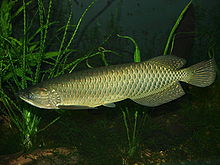Osteoglossidae
| Osteoglossidae Temporal range:
| |
|---|---|

| |
| Scleropages leichardti, a fish endemic to Queensland | |
| Scientific classification | |
| Domain: | Eukaryota |
| Kingdom: | Animalia |
| Phylum: | Chordata |
| Class: | Actinopterygii |
| Order: | Osteoglossiformes |
| Suborder: | Osteoglossoidei |
| Family: | Osteoglossidae Bonaparte, 1831 |
| Genera | |
|
See text for extinct taxa | |
Osteoglossidae is a family of large freshwater fish, which includes the arowanas and arapaima. They are commonly known as bonytongues. The family contains two extant subfamilies Arapaiminae and Osteoglossinae, with a total of five living genera.[1] The extinct Phareodontinae are known from the Late Cretaceous and Paleogene.[2]
Osteoglossids are basal teleosts that originated some time during the Cretaceous, and are placed in the actinopterygiid order Osteoglossiformes. As traditionally defined, the family includes several extant species from South America, one from Africa, two from Asia, and two from Australia.[3] Although currently restricted to freshwater habitats in the tropics, the group was much more widespread during the Cretaceous and Paleogene, with genera known from North America and Europe, including marine taxa such as Brychaetus. An indeterminate marine osteoglossid is known to have inhabited the seas around Greenland in the Early Paleocene.[4] The earliest known osteoglossid is Cretophareodus from the middle Campanian of the Dinosaur Park Formation, Canada.
The following taxa are known from the family:[2][5][6][7]
- Family Osteoglossidae
- Genus ?†Chauliopareion (possibly a basal osteoglossiform)[2]
- Genus ?†Singida (possibly a basal osteoglossiform)[2]
- Subfamily Arapaiminae
- Genus Arapaima
- Genus Heterotis
- Genus ?†Joffrichthys (possibly a basal osteoglossiform)[8]
- Genus †Sinoglossus
- Genus †Thrissopterus
- Subfamily Osteoglossinae
- Genus Osteoglossum
- Genus Scleropages
- Subfamily †Phareodontinae
- Genus †Brychaetoides
- Genus †Brychaetus
- Genus †Cretophareodus
- Genus ?†Foreyichthys
- Genus †Furichthys [2][7][9]
- Genus ?†Heterosteoglossum
- Genus †Macroprosopon[10]
- Genus †Magnigena
- Genus †Monopteros
- Genus †Musperia
- Genus ?†Opsithrissops
- Genus †Phareoides
- Genus †Phareodus
- Genus †Phareodusichthys
- Genus †Ridewoodichthys
- Genus †Taverneichthys
- Genus †Xosteoglossid
References[edit]
- ^ "Arapaim availability". Britannica. Retrieved 1 February 2022.
- ^ a b c d e Hilton, Eric J.; Lavoué, Sébastien (2018-10-11). "A review of the systematic biology of fossil and living bony-tongue fishes, Osteoglossomorpha (Actinopterygii: Teleostei)". Neotropical Ichthyology. 16: e180031. doi:10.1590/1982-0224-20180031. ISSN 1679-6225.
- ^ Allen, G. R.; Midgley, S. H.; Allen, M. (2002). Field Guide to the Freshwater Fishes of Australia. Perth: Western Australia Museum. pp. 56–58. ISBN 0-7307-5486-3.
- ^ Capobianco, Alessio; Foreman, Ethan; Friedman, Matt (2021). Cavin, Lionel (ed.). "A Paleocene (Danian) marine osteoglossid (Teleostei, Osteoglossomorpha) from the Nuussuaq Basin of Greenland, with a brief review of Palaeogene marine bonytongue fishes". Papers in Palaeontology. 7 (1): 625–640. doi:10.1002/spp2.1291. hdl:2027.42/167033. ISSN 2056-2799.
- ^ Hilton, Eric J.; Carpenter, Jeffrey (2020). "Bony-Tongue Fishes (Teleostei: Osteoglossomorpha) from the Eocene Nanjemoy Formation, Virginia". Northeastern Naturalist. 27 (1): 25–34. doi:10.1656/045.027.0102. ISSN 1092-6194.
- ^ Bonde, Niels (2008). "Osteoglossomorphs of the marine Lower Eocene of Denmark – with remarks on other Eocene taxa and their importance for palaeobiogeography". Geological Society, London, Special Publications. 295 (1): 253–310. doi:10.1144/SP295.14. ISSN 0305-8719.
- ^ a b Capobianco, Alessio (2021). Paleontological Data Reveals Unexpected Biogeographic Histories of Extant Organisms: Bonytongue Fishes (Teleostei: Osteoglossomorpha) as a Case Study (Thesis thesis).
- ^ Murray, Alison M; Zelenitsky, Darla K; Brinkman, Donald B; Neuman, Andrew G (2018-02-09). "Two new Palaeocene osteoglossomorphs from Canada, with a reassessment of the relationships of the genus †Joffrichthys, and analysis of diversity from articulated versus microfossil material". Zoological Journal of the Linnean Society. 183 (4): 907–944. doi:10.1093/zoolinnean/zlx100. ISSN 0024-4082.
- ^ Capobianco, Alessio; Zouhri, Samir; Friedman, Matt (2024-04-17). "A long-snouted marine bonytongue (Teleostei: Osteoglossidae) from the early Eocene of Morocco and the phylogenetic affinities of marine osteoglossids". Zoological Journal of the Linnean Society. doi:10.1093/zoolinnean/zlae015. ISSN 0024-4082.
- ^ Capobianco, Alessio; Zouhri, Samir; Friedman, Matt (2024-04-17). "A long-snouted marine bonytongue (Teleostei: Osteoglossidae) from the early Eocene of Morocco and the phylogenetic affinities of marine osteoglossids". Zoological Journal of the Linnean Society. doi:10.1093/zoolinnean/zlae015. ISSN 0024-4082.



